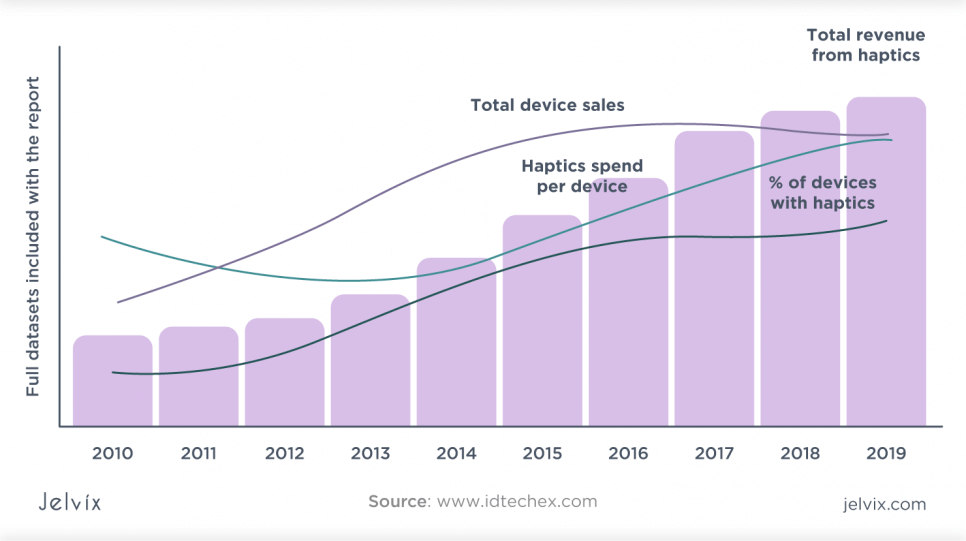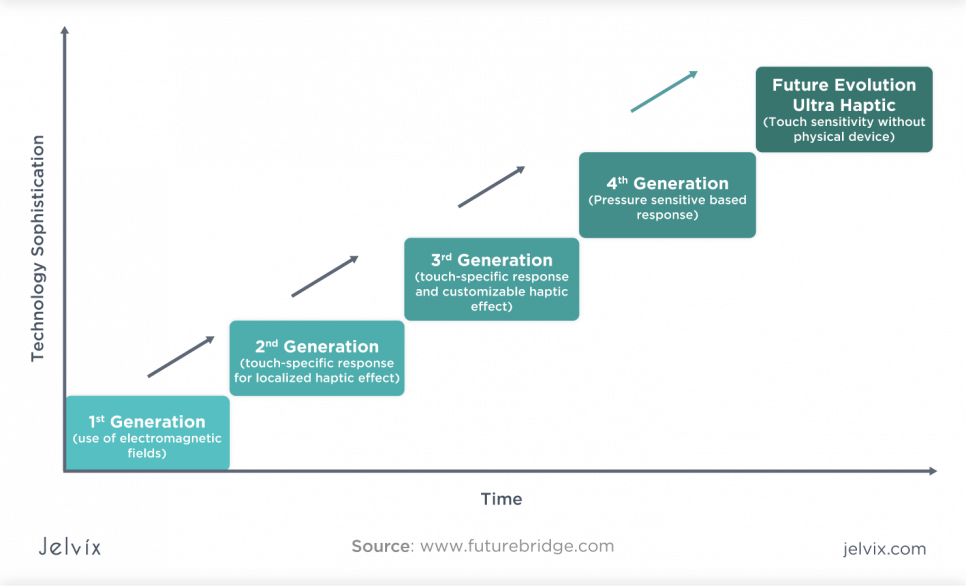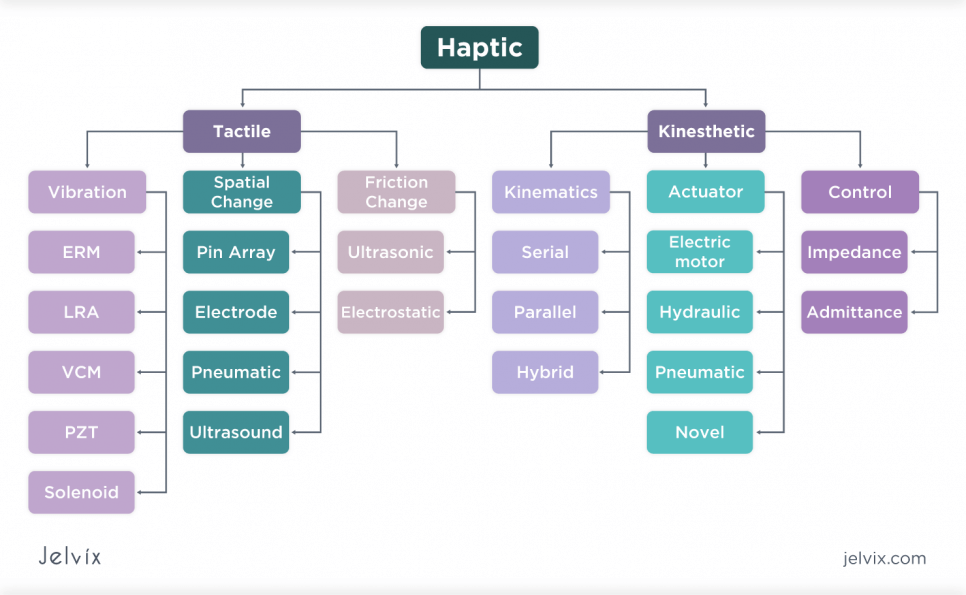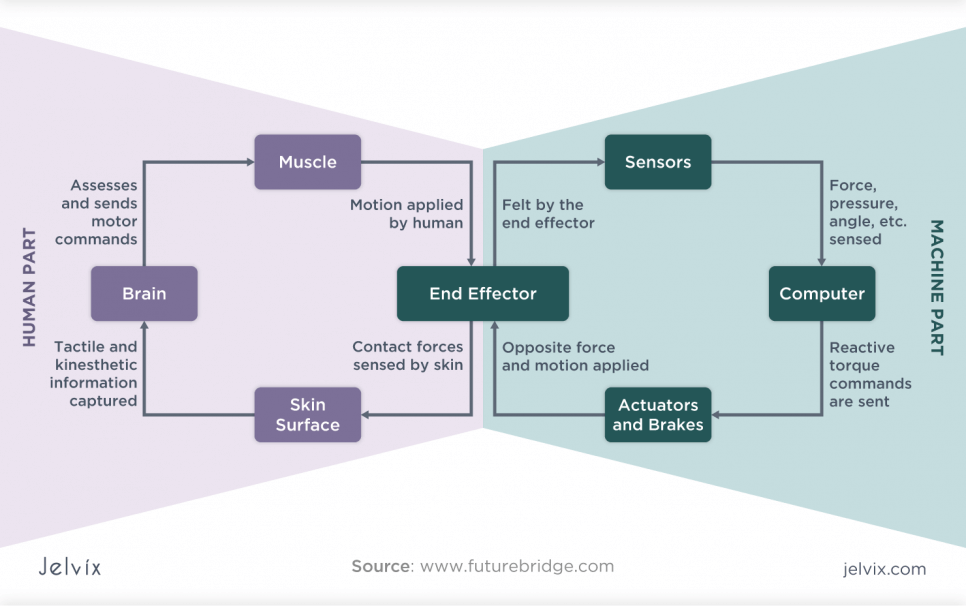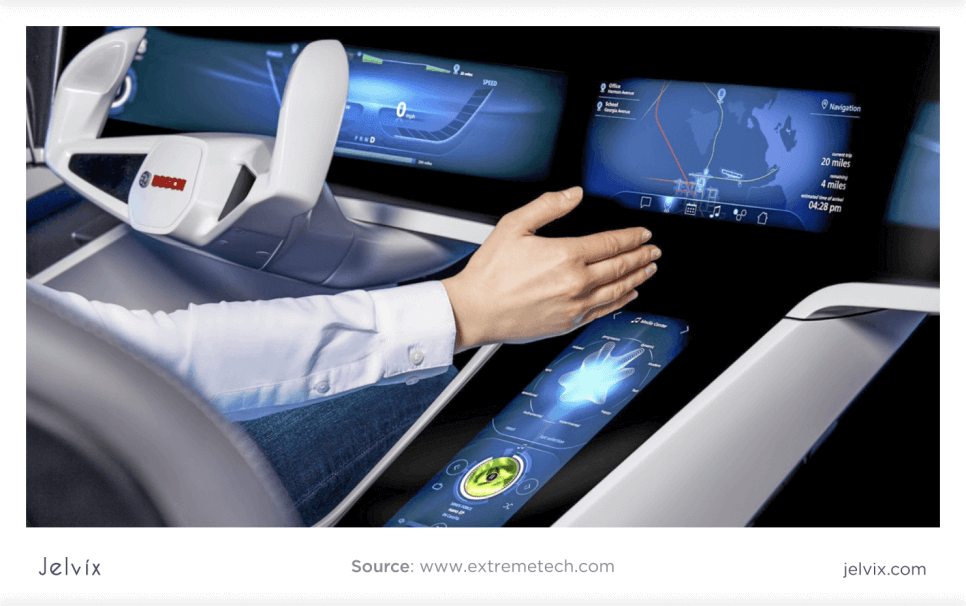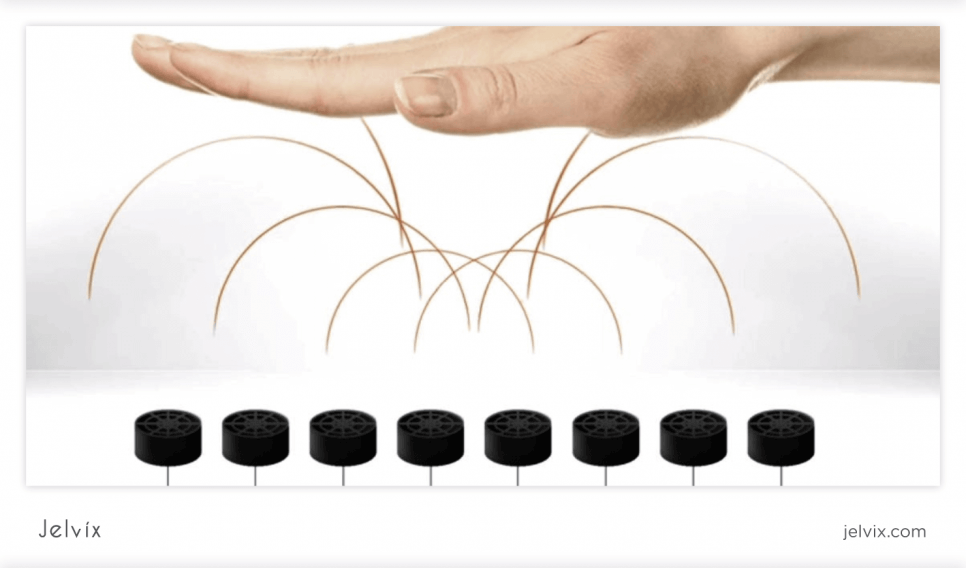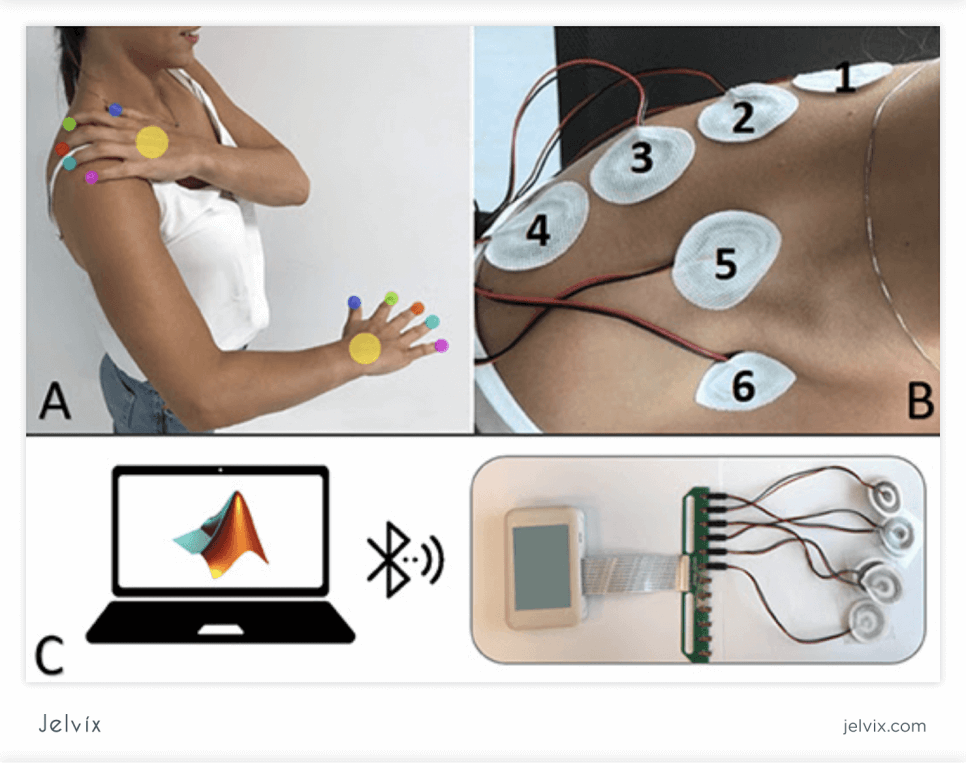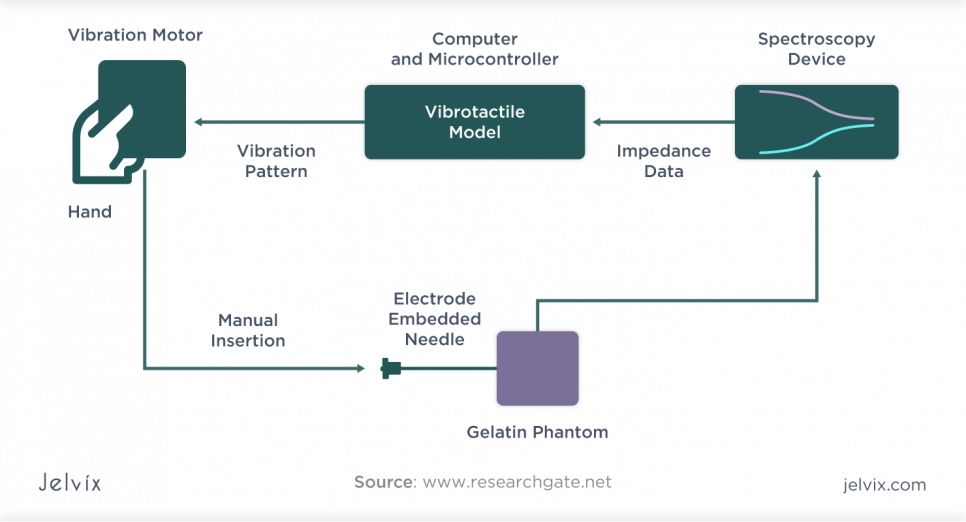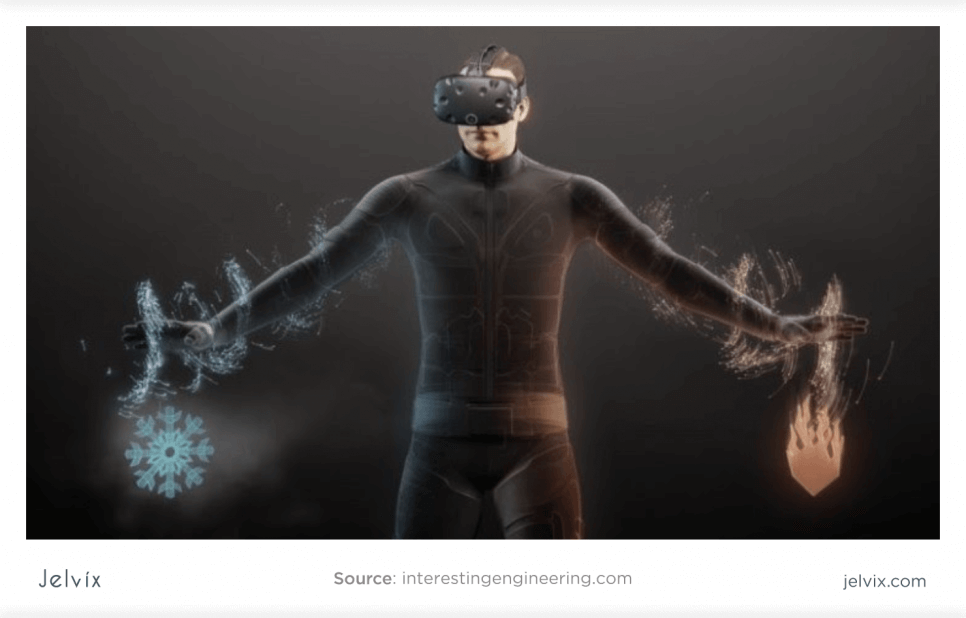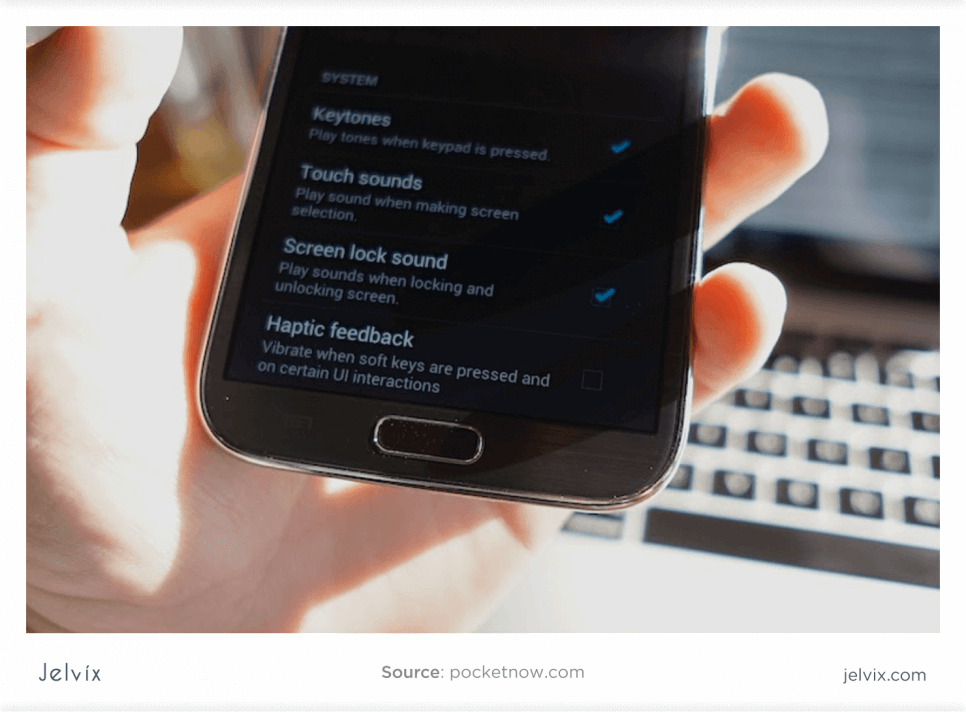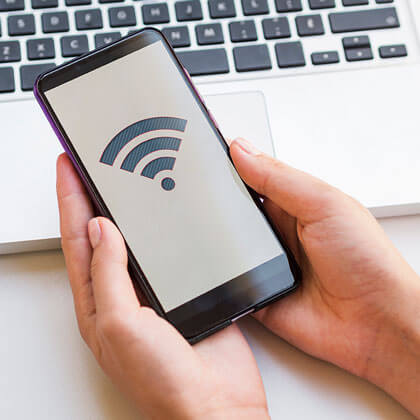Tactile technologies are already actively used in multiple types of electronic devices. Examples include simulating physical feedback by a phone vibration, smartwatch, or even a vehicle and very realistic tactile sensations in advanced kinds of virtual reality platforms.
The tactile sensation industry is projected to grow to $19 billion by 2025. As a result, all large electronics manufacturers are investing heavily in tactile technology.
This is not surprising, as involving touch in human-computer interaction improves navigation, communication, gaming experience, robot control, physical rehabilitation, education, and even online shopping.
Therefore, if you have an application or plan to develop it, it is worth adding haptic feedback.
Haptic History
The study of haptic feedback had begun a long time ago, but the technology became mainstream until the late 1970s with the advent of video games. The tactile motors of arcade game controllers mimicked impacts; for example, the steering wheel of a racing car vibrated every time it ran into an object.
By the 1990s, it have already used the tactile sensation in portable home game console controllers. Companies had also tried to create consumer products that enable tactile feedback from devices and “feel” virtual objects.
However, consumers did not have broad access to practical products ready for the market. The technology was costly and mainly used as a remote manipulation system, for example, to handle radioactive materials.
The ubiquity of digital devices and the decline in equipment costs led to active efforts to optimize and adapt this promising technology to today’s digital environment. It has transformed from a tactile remote control system into a controlled tactile system (in virtual reality), sensory tactile devices, and, finally, wearable tactile devices.
What Does Haptic Mean?
First, “haptic,” means anything that involves touch and comes from the Greek word haptikos. “Tactile” sensations, familiar to each of us as touch, are part of the so-called somatosensory system. It comprises at least twelve specialized types of receptors throughout the surface of the human body and inside it.
Each of them sends different information to the human brain: one about vibration, another about pressure, the third about pain, and so on. Tactility is the second most important way of understanding, exploring, and interacting with the world after seeing.
But the haptic definition in science and technology is more accurate. It boils down to using tactile sensations in interfaces to convey information to the end-user through touch. The interface provides the operator with physical sensations such as vibrations or impulses, creating the illusion of interacting with the simulated object.
These sensations can be tactile (feeling the surface or texture of a virtual object) or kinesthetic (feeling the weight and size of an object).
What is Haptic Feedback?
A haptic is often confused with haptic technology (particular technologies that imitate tactile sensations) and haptic feedback (a way to communicate with users).
Although the terms are closely related, it should be clarified that tactile sensitivity is a broader category that includes not only everything related to tactility but also the neurobiology and physiology of touch.
In practice, haptic feedback targets a specific subset of the human somatosensory system. Its impact is likely to expand with advances in technology. However, Microsoft said it was “orders of magnitude harder” to model tactile feedback than sight or sound.
Almost all tactile devices, from mobile phones and game controllers to “virtual touch” devices, interact exclusively with the receptors in our hands. But even limited use of haptic feedback is very efficient, as the tactile system enhances the immersion in the digital environment. And in practical applications, it offers more granular control over equipment or robotics by intuitively responding to slight movements of the operator’s hands or fingers.
How it Works
Tactile technology generates computer signals that are perceived through touch. It integrates human and machine parts. The machine side includes sensors, actuators, real-time algorithms, application program interfaces, and end effectors. The entire system is controlled by a computer, which sends the commands to the human part through the final effector.
In most cases, the technology uses a motor called “a drive” that converts electrical, hydraulic, or pneumatic energy into triggers that can be controlled by software that determines the duration, amplitude, and frequency. Interfaces that use tactile controls have attributes such as shape, texture, vibration, resistance to motion, etc. In general, there are two types of tactile research modes that can be distinguished.
Passive Systems
Systems with passive haptic feedback are those structures that contribute through the tactile properties of mechanical structures, physical objects, and friction. Passive tactile sensations convey the feeling of being guided. In addition, the directional nature of passive tactile sensations makes it easy to recognize the direction of the path. Thus, they can be effectively used in more complex tasks such as aiding navigation/mobility.
Active Systems
The essence of active tactile sensation is that a user deliberately explores the tactile surface (usually with the fingertips or palms). Active tactile sensations take precedence over passive tactile sensations when it comes to recognition. This is mainly because of purposeful actions that facilitate the perception of the solidity of the object.
Benefits of Haptic Technology
You might think that the function of tactile sensations is solely to enhance the “reality” of the virtual experience. But that’s just one of the reasons companies add tactile sensations to apps. Most people are familiar with haptic feedback when using their smartphones. However, the smartphone is just the tip of the iceberg when compared to the capabilities of real applications with tactile feedback.
Utilizing haptic feedback increases the performance of anyone using a digital device with this feature. The information conveyed to the user is presented in such a way that users can focus on their tasks. For example, medical devices with tactile feedback help patients take their medications on time.
One example of increased precision is a virtual keyboard for typing on a touch screen. The “button press” vibration effect allows the user to understand that the computer, phone, or tablet sensed the keypress and responded differently than the “long press” effect. This subtle typing distinction eases frustration, allows the user to type with more precision, and feels more like typing on a true keyboard or typewriter.
Another illustration of improved usability through haptic feedback is the car parking sensor. In older models, the vibration was turned on only when the steering wheel of the car approached the object by a certain number of centimeters.
In the latest car models, the driver receives information about the environment using vibrations of different strengths and frequencies for discrete events. Vibration has also replaced the annoying audible warnings of older models, so drivers can use the parking sensor even in noisy or hard-of-hearing environments.
A Typology of Haptic Feedback
Tactile feedback and the various vibrations, patterns, and sensations it creates are easily accessible to everyone and difficult to misinterpret. Our fingers can remember minor details of subtle vibrational changes and rapidly signal what they mean because the fingertips are one of the most sensitive areas of the human body. It’s like studying a new language, but much easier and more natural for human perception.
All tactile technologies are trying to achieve the same aim – to recreate tactile sensations using various kinds of stimuli. Some tell about the texture of the object, others – about physical properties, for example, weight or pressure. This is the essence of haptic feedback – creating a new layer that stimulates your senses whenever you interact with it. There are five types of haptic technologies:
Force Feedback
This kind of haptic technology was the first to emerge. Unlike other types that act on skin receptors, force feedback acts on the ligaments and muscles in the musculoskeletal system. They are classified into:
Biomimetics, which move like human limbs and resemble them in shape. Because the devices imitate the functionality of the human body and are designed for different personalities, their development is difficult and costly.
Non-biomimetic, which can be of any shape.
Also, force feedback devices can be divided into resistive and active. Resistive devices restrict the movement of the user using brakes. Active devices restrict the user’s movements or move the body in space using motors. They can simulate a broader range of interactions, but they usually have to be more potent than passive devices and more difficult to control.
Ultrasonic Haptic Feedback
Ultrasound is a high-frequency sound wave that is generated using one or more emitters. One emitter on one part of the housing signals to the other part. This transmission principle is called “acoustic time-reversal.”
For extensive areas, a tactile feedback field is formed using multiple emitters. Together they create invisible, tactile interfaces in the air – turbulence that can be felt through the skin. The primary advantage of ultrasonic feedback is the absence of any wearable accessories. This kind of feedback is quite costly and less tangible than vibrotactile or electrotactile.
Electrotactile Feedback
Electrical muscle stimulation has been used in the medical sphere for over 30 years and has long proven safe. In addition, electrical signals are at the core of the nervous system, so this type of feedback is well suited for simulating and generating sensations.
Electrotactile stimulants act with electrical impulses not only on receptors but also on nerve endings. As a result, a person wearing a tactile device such as a glove or suit can feel the texture of an object or a breath of wind. Almost any sensation can be stimulated with electrical impulses. Feelings can also vary based on the intensity and frequency of stimuli affecting the human’s skin, as well as amperage, voltage, material, waveform, electrode size, contact strength, hydration, and skin type.
The system’s main advantage is the absence of any complex mechanics and a wide range of sensations that cannot be reproduced by any other feedback system. Electrodes can be configured in compact arrays to be used to complete electrotactile displays.
Thermal Feedback
A grid of actuators is used to generate thermal feedback, which is in direct contact with the skin. Thermal feedback does not require many actuators, and they can be positioned less closely together. Therefore, it is easier to manufacture devices with thermal feedback. The downside is that tactile suits that utilize thermal feedback need more energy.
Vibrotactile Feedback
Vibration stimulators apply pressure on touch receptors in the human skin, which can pick up vibrations of up to 1000 hertz. The effects of vibration can be regarded as a kind of sound to the skin. It is a relatively easy and low-cost technology and has long been used in many devices such as joysticks, steering wheels, and smartphones. Vibration feedback is less energy-intensive and requires fewer tracking parameters.
Vibration motors do not provide depth and variety of sensations and can annoy users. Moreover, it is challenging to miniaturize them effectively. In addition, with prolonged use, perceptible vibrotactile feedback harms the ligaments and joints.
Where is Haptic Feedback Used?
The range of tactile performance in today’s world ranges from widely available applications in the consumer electronics and automotive industries to various forms of sophisticated medical and scientific applications.
Tactile technologies can be found in:
- Teleoperation, where remotely controlled robotic tools enable remote environments to be monitored.
- Virtual environment, where haptic feedback is a necessary part of any VR interactions. The list includes simulators, control systems, and specialized models that allow touch interaction with virtual objects.
- Mobile devices where haptic technology is used to provide functions such as vibration feedback of tablets, smartphones, and wearables touch screens.
Learn more about the areas of healthcare in which virtual reality is widely used.
What is an Example of Haptic Feedback?
In the field of consumer electronics, the best known tactile sensations are vibration systems on smartphones and tablets, which allow messages and calls to be transmitted without sound or optical signals.
A popular example of haptic feedback is the Apple Macbook. Since 2016, all Macbook trackpads have had a feature that makes an extra click when you press harder on the screen with your finger. If you have the Force Click option enabled, clicking on a word with that extra pressure will search for its definition. The latest versions already have Haptic Touch.
Tesla’s suit motion capture system employs sensors to convey the exact position of the body in a virtual environment. Entire body tactile feedback and motion capture in a thermo-controlled suit take the user even deeper into the virtual world.
Design company WearWorks has developed a tactile bracelet that guides visually impaired people with simple vibration signals.
The Alert Shirt is probably the first of its kind that is designed with tactile sensations to give the viewer a feel for the stadium atmosphere. It makes you feel you are part of a football match. The wearer of this jersey can feel everything, such as the collision of players or the rapid heartbeat of a football player after a long sprint.
What Does Haptic Feedback Mean on Android and iPhone Apps?
You probably feel your Android phone or iPhone vibrate when you press certain navigation buttons or type a message. This is the tactile sensation. Now, you already know what haptic feedback is – it is a kind of physical reaction to virtual action. Part of the feedback is usually a physical response based on the user’s touch of the screen and, most often, vibration. The physical response adds another way of getting information about the performed action. This allows you to feel the feedback from the interface as you type or notice that the phone is unlocked while it is still in your pocket.
Since the screen of the device is just smooth glass, it would be challenging to feel tactile feedback without vibration. This is the crucial difference between the virtual keyboard and the real one, which allows you to feel that you have pressed a key. The mouse (and some touchpads) also speak to the click action when the button is pressed.
A haptic alert is simply an alert or a push notification that includes some vibrations or a buzz. Unlike haptic touch, which involves a response to the user’s action, an alert arises without any input from the user. Haptic app developers may integrate these tactile alerts in addition to auditory alerts or the place of an auditory alert when the device is in silent mode.
From a user experience and engagement perspective, the benefit of a haptic alert is quite clear: the app can silently and effectively capture the user’s attention, whether the device is in a pocket, purse, or even laid nearby. Haptic alerts are also very convenient for scenarios where the user is in a loud environment, making it difficult to hear a ring or ding.
The best thing about haptic feedback on Android or iPhone devices is that it can be customized. The OS itself is open-source, which means OEMs and developers can customize things the way they like, including leaving a choice for the user about how much tactile feedback to use.
Types of Haptic Feedback in Your Application
Since haptic feedback is a vibrational response that can accompany every scrolling, sliding, or tapping you make in an app, it’s essential to understand when it appends value and when it gets annoying.
For example, feeling a slight vibration whenever an app has completed a crucial action ameliorates the UX. This provides positive feedback that is closely related to a specific action. But if every app button or action has a vibration, it quickly loses its charm and promptly gets in the way. Hence, careful consideration of the appropriateness of haptic feedback is key to success.
There are two types of haptic feedback that can be applied in an application.
- Temporary feedback is a brief impact that appears and disappears. It can draw attention, warn of an error, and accompany some short action. The clarity of the tactile sensation makes your application richer and more lively.
- Continuous feedback is more like a sequence of tactile sensations. Continuous tactile events have a particular duration. For example, in a racing game, this is a constant vibration of the engine of a moving car or its change at high speeds.
For the best tactile experience, these types can be combined. The application can involve both temporary and continuous tactile sensations. The principal thing is not to overdo it. Not all actions need tactile support, and everyone should trigger an event.
Here’s an overview of the apps that may include haptic feedback:
- Applications for notifications and calendar, camera, photos – view information, add reminders, appointments, tasks, alarms.
- Phone management apps – for adding and searching for a contact, viewing the last call and last voicemail.
- Fitness apps – view templates, exercise, and share activities.
- Chats and social apps – notifications for new messages, group invitations, profile visits, and more.
The Next Challenges for Haptics
Smartphones have so far remained a key market for tactile sensations, enabling the industry to achieve unprecedented sales volumes. But the growth of this market has slowed down for now since there has been a shift towards more natural sensations and interactions.
While tactility in smartphones has reached its top, its use in virtual reality is actively developing. Researchers are currently focusing on the control and management of tactile interactions with holograms and virtual objects. If this research is successful, progress could be made in, among others, the gaming, film, manufacturing, and medical industries.
Adding haptic feedback is widespread in the automotive industry, from various driver alert systems to infotainment systems and beyond.
Using tactile learning with video and audio has proven effective as a valuable teaching and skill development tool across many industries.
Output
The world has already realized how important tactile sensitivity is. Therefore, haptic feedback and tactile devices are the next stages in the development of digital technologies to provide more natural and intuitive ways to interact with interfaces.
There is a reason why we at Jelvix recommend implementing haptic technology. We believe it opens up exciting new opportunities not only for developers but also for users. Using tactile sensations in your application will take it to the next level and create a richer and more holistic experience.
Need a certain developer?
Access top talent pool to reach new business objectives.



